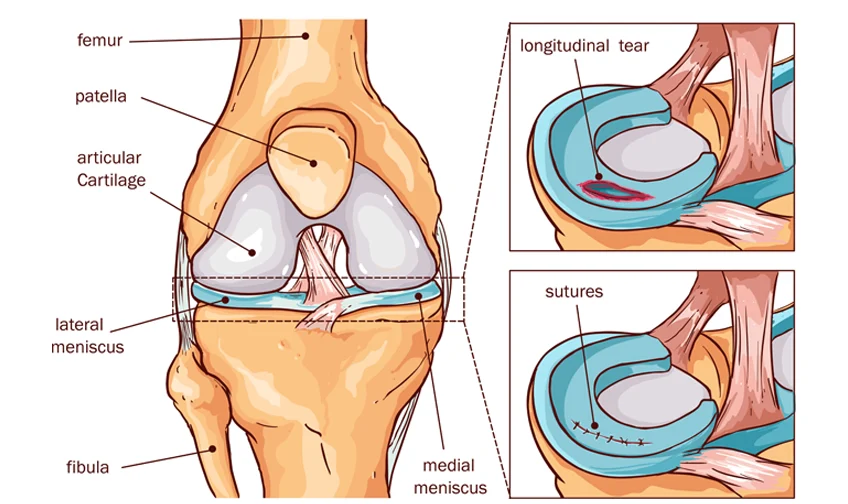Meniscus Tear

A meniscus tear is one of the most common knee injuries, occurring when the meniscus, a crescent-shaped piece of cartilage in the knee, is torn. The menisci (plural for meniscus) act as shock absorbers between the thigh bone (femur) and the shin bone (tibia), helping to cushion and stabilize the knee joint. Tears are typically caused by twisting or rotating the knee, especially while bearing weight.
Types of Meniscus Tears
There are different types of meniscus tears based on their location and pattern, including:
- Radial Tear: Extends from the inner edge of the meniscus outward.
- Bucket Handle Tear: A large tear where a portion of the meniscus is displaced, often leading to knee locking.
- Flap Tear: A small flap of the meniscus is torn.
- Degenerative Tear: Common in older adults due to wear and tear over time.
Causes of Meniscus Tear
- Sudden twisting or turning movements, often seen in sports such as basketball, soccer, or tennis. Direct impact to the knee during activities like football or rugby.
- Aging: As we age, the meniscus can become more brittle, making it more prone to tearing from even minor motions.
- Squatting or lifting heavy objects awkwardly.
Symptoms of Meniscus Tear
- Pain in the knee, especially when twisting or rotating it.
- Swelling that develops over 1-2 days.
- Stiffness and difficulty moving the knee.
- Catching or locking of the knee joint.
- A sensation that the knee may "give way" or feels unstable.
- Inability to fully straighten the knee.
Diagnosis
A doctor will perform a physical examination, which may include specific tests like the McMurray test, where the doctor moves your knee in certain ways to check for pain or clicking. Imaging tests, such as an MRI, are often used to confirm the diagnosis and assess the severity and location of the tear.
Treatment for Meniscus Tear
Treatment options for a meniscus tear vary depending on the type, size, and location of the tear, as well as the patient's age and activity level. The treatment can be non-surgical or surgical.
Non-surgical Treatment (Conservative)
For smaller or degenerative tears, particularly in older adults, non-surgical treatment may be effective.
- Rest: Avoid activities that cause knee pain.
- Ice: Apply ice packs to reduce swelling and pain.
- Compression: Use a knee brace or wrap to limit movement and provide support.
- Elevation: Keep the knee raised to reduce swelling.
- Physical Therapy: Specific exercises to strengthen the muscles around the knee and restore range of motion.
- Medications: Over-the-counter pain relievers like ibuprofen or naproxen can help reduce pain and inflammation.
Surgical Treatment
For larger tears, tears in younger individuals, or if non-surgical treatment fails, surgery may be necessary. There are two main types of surgeries for meniscus tears
Meniscectomy
In this procedure, the damaged portion of the meniscus is removed. It is often performed when the tear is in an area with poor blood supply and cannot heal on its own.
Meniscus Repair:
In this procedure, the torn pieces of the meniscus are sewn back together. This is preferable for tears in areas with good blood supply (often referred to as the "red zone"), where healing is more likely. Recovery time is generally longer than with a meniscectomy because the repaired tissue needs time to heal.
Both procedures are usually done arthroscopically, a minimally invasive surgical technique where a small camera is inserted into the knee joint through tiny incisions.
Recovery After Meniscus Surgery
Meniscectomy: Recovery typically takes 3 to 6 weeks, depending on the extent of the tear and the patient’s activity level.
Meniscus Repair: Because the tissue needs time to heal, recovery can take 3 to 6 months. During this time, physical therapy is essential to regain strength, flexibility, and stability in the knee.
Risks of Surgery
While meniscus surgery is generally successful, there are some potential risks, including:
- Infection.
- Stiffness or loss of motion in the knee.
- Blood clots.
- Damage to nearby structures such as nerves or blood vessels.
- Re-tearing of the meniscus, especially if the knee is not adequately protected during recovery.

